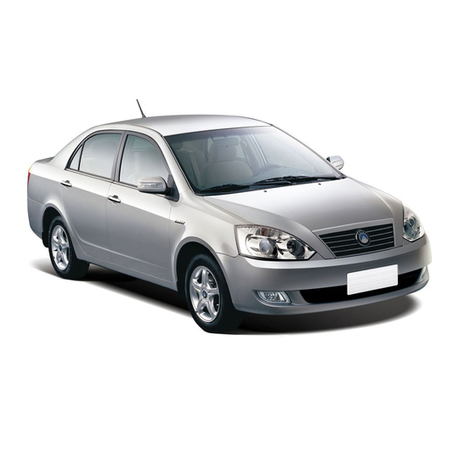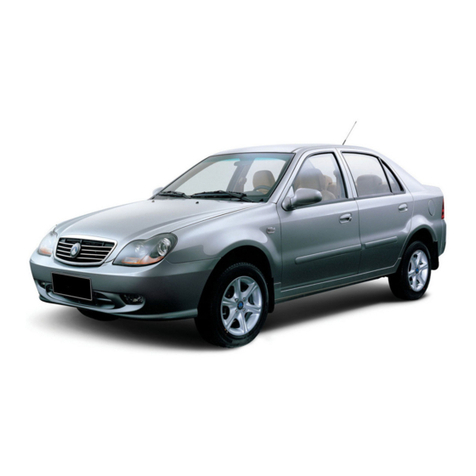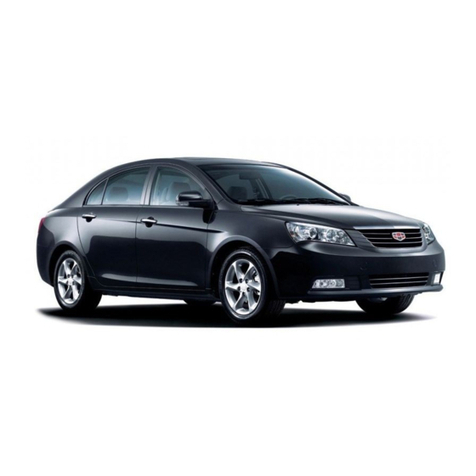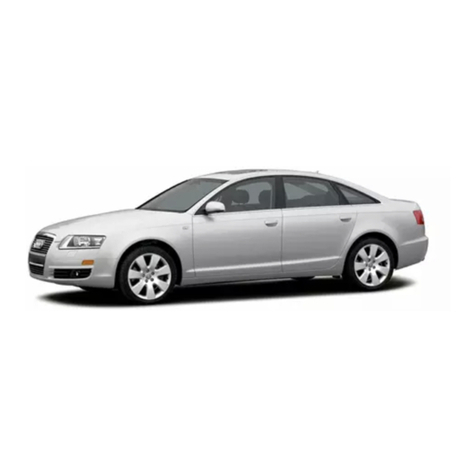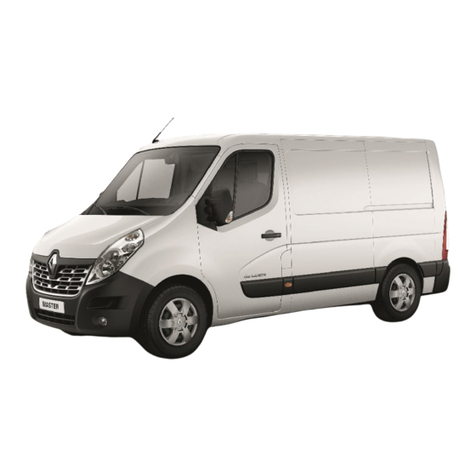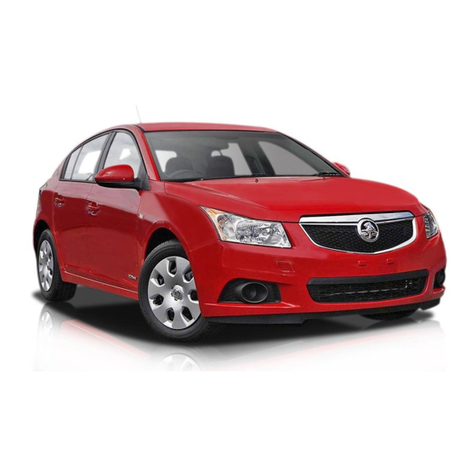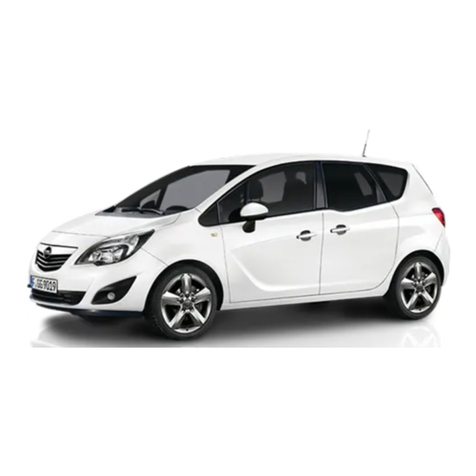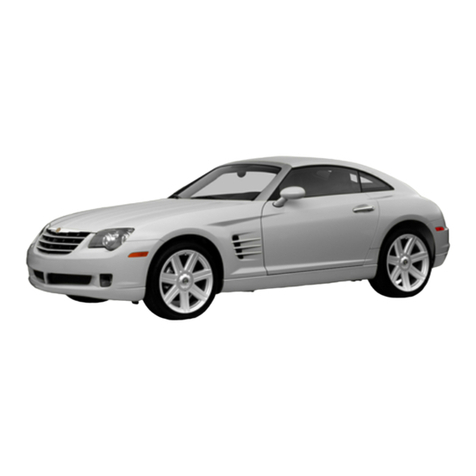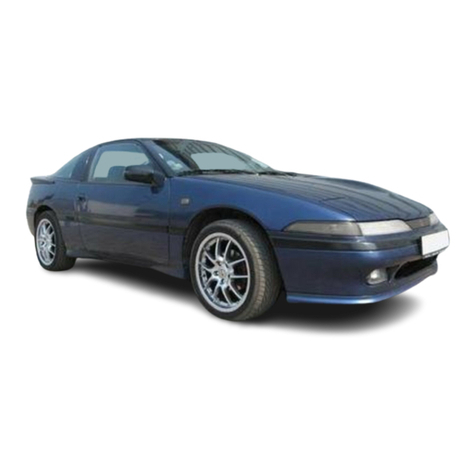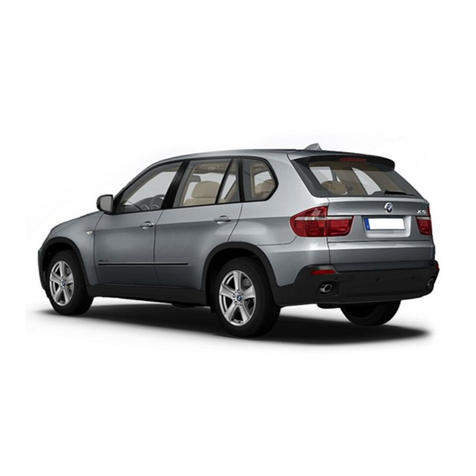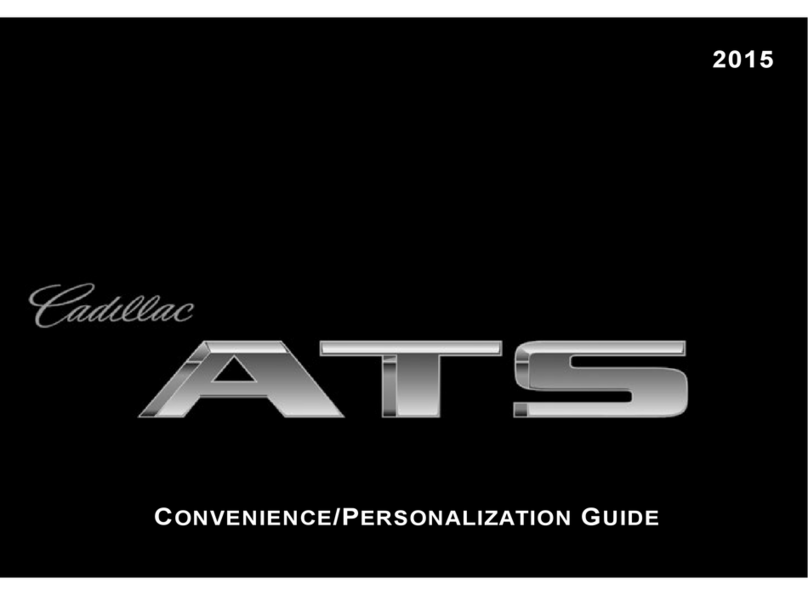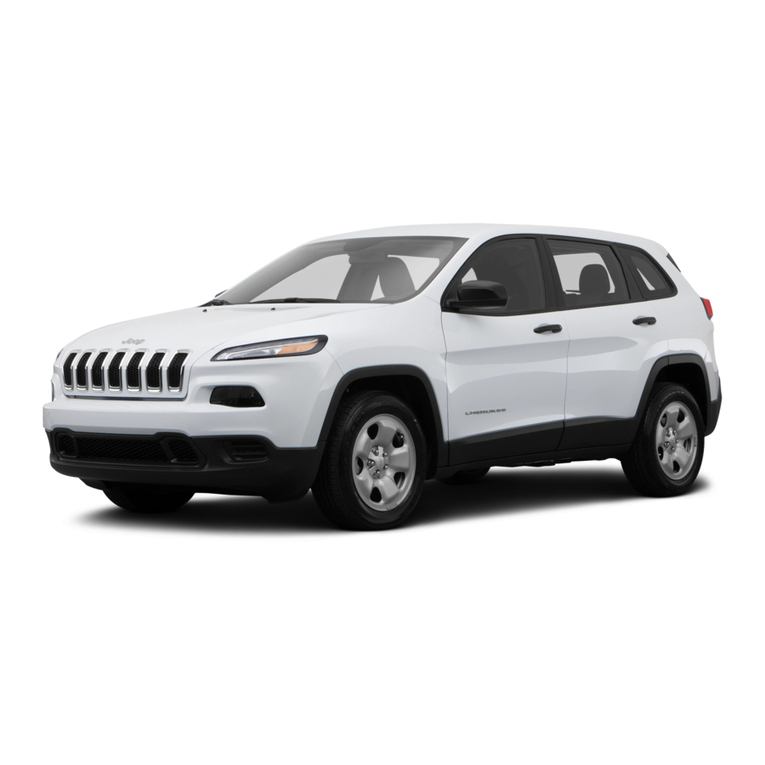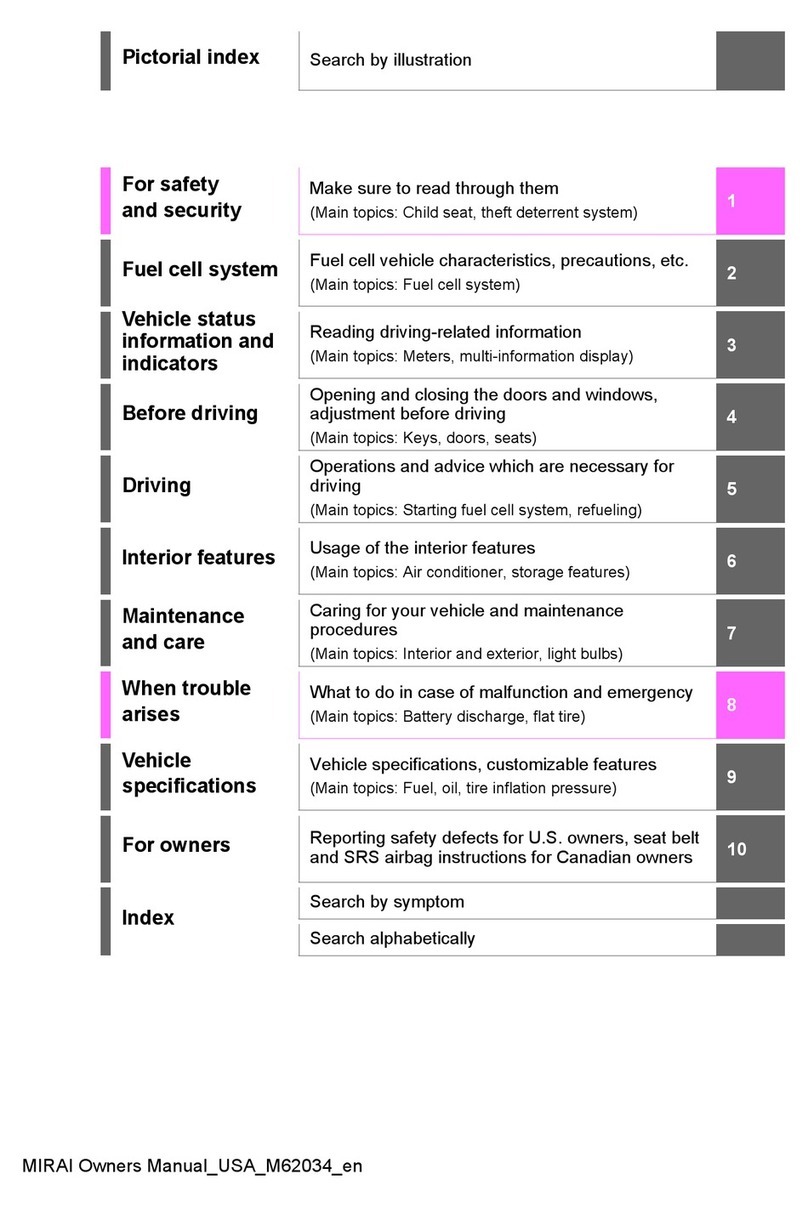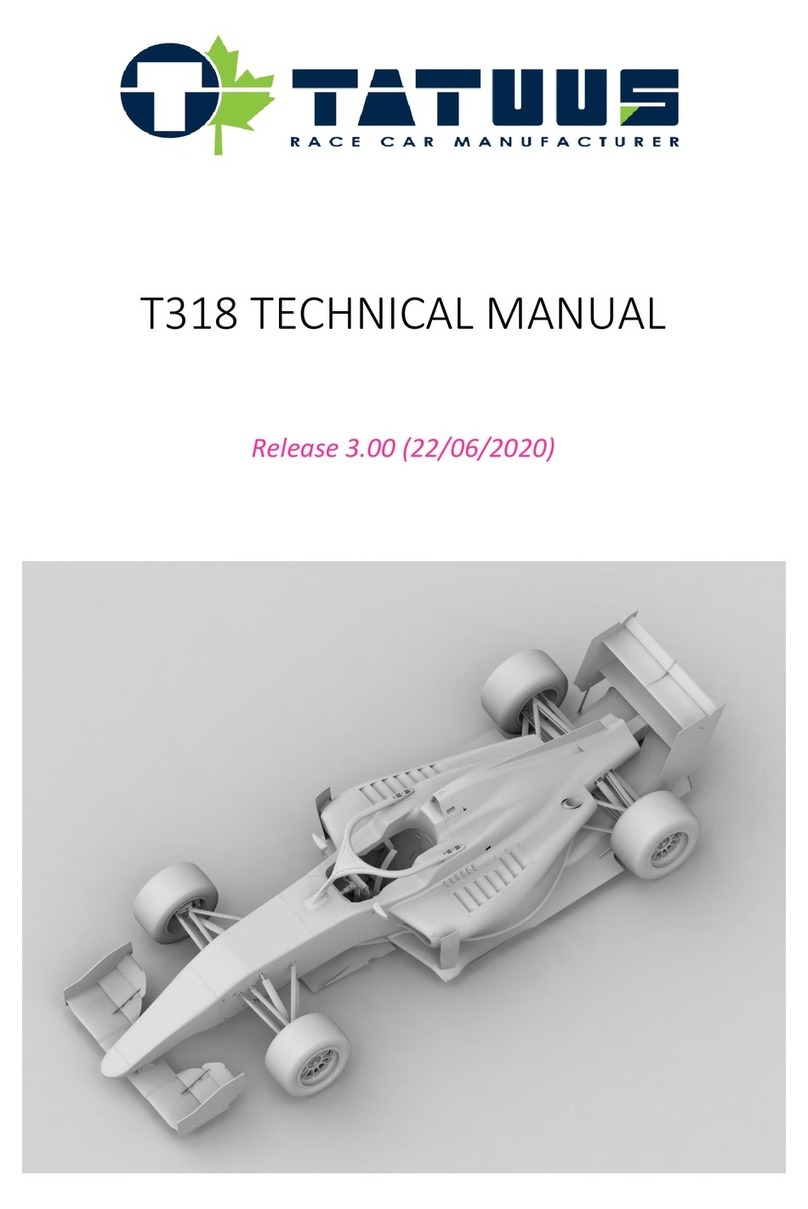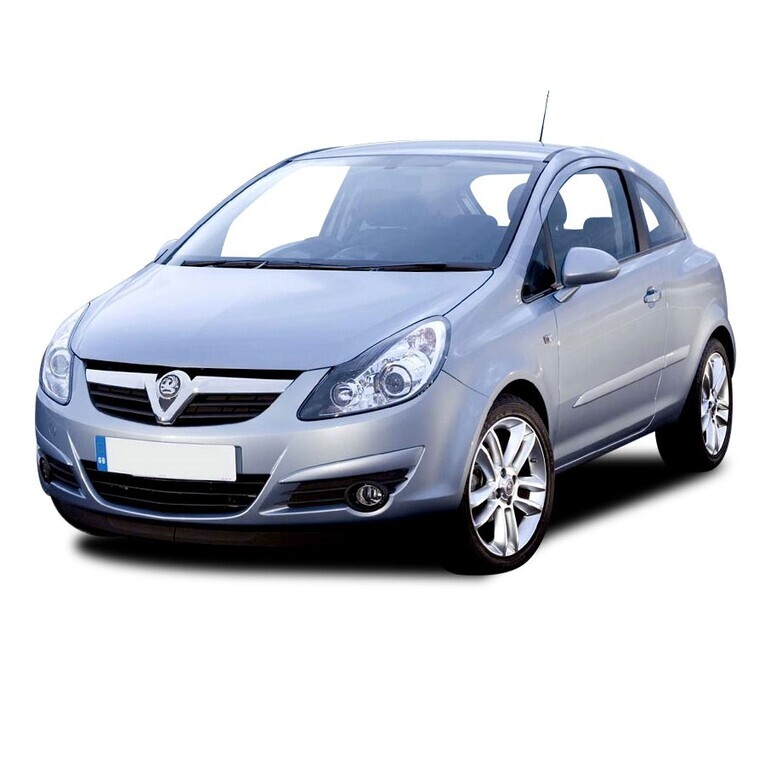Geely MK Series User manual



Foreword
Thanks for your preference for Geey Automobile and your selection of Geely “MK” series car which is a notchback
model of ve seats and ve doors latest launched by Geely Zhejiang Haoqing Automobile manufacturing Co., Ltd. This
user manual illustrates the operation of the new car, please read it carefully and make sure that all passengers in the car
follow these instructions. By doing this, you can enjoy agelong safe driving and reduce the driving faults. Please refer to
the following pages carefully for the important information about this manual and the car. Geely service station can pro-
vide quality servicing and any help you need.
If you are in need of servcing, please bear in mind that Geely service station has best understanding of your car and
are very pleased to meet your requirements.
When transferring the vehicle, please remember to hand over this user manual to the new owner who also need to
learn the knowledges in this respect.
All data and specications in this manual are latest by the time of publication of this manual. However, since Geely
offers ongoing improvement to its product, Geely reserves the right for change at any time without notice.
Please be noticed that this manual is applicable to all models of MK series and illustrates all equipments and de-
vices including the optional service parts, therefore, some of the descriptions or equipments may not be aplicable to your
vehicle.
All rights reserved, no transfer or copy of part or all of this manual is allowed without prior written consent of Geely.
Editor

Important Information in This Manual
Safety and Vehicle Damage Warning
There are safety warning and vehicle damage warning in this man-
ual, you have to avoid the possible body injury or vehicle damage
by following the instructions in these warnings.
The types of warnings in this manual are described as below:
Safety Mark
Notice
For warning: negligence of the warning will result in vehicle or
equipment damage. The driver shall be prompted what to do or
not to do in order to avoid or reduce the chance of damage to the
vehicle or equipments.
When the above safety mark is seen, it indi-
cates “no”, “do not” or “never let it happen”.
Warning
For warning: negligence of the warning will result in human
body injury. The driver shall be prompted what to do or not to
do in order to lower the risk of injury to himself and others.

Part I. Operation of the Instruments and Controllers
1. Instrument Panel Overview ............................................1
2. Combination Meter Overview ........................................5
3. Indicators and Alarm in the Instrument Mounting Plate ... 11
4. Key ...............................................................................14
5. Central Door Lock Transmitter .....................................16
6. Door ............................................................................19
7. Operation of Power Window ........................................21
8. Trunk Lid ......................................................................23
9. Engine Hood ................................................................24
10. Fuel Filler Cap ...........................................................26
11. Moonroof ....................................................................27
12. Seat ...........................................................................30
13. Seat Belt ....................................................................33
14. Child Safety Device ...................................................38
15. Air Bag .......................................................................42
16. Outside Rearview Mirror ............................................48
17. Anti-glare Inside Rearview Mirror ..............................50
18.Vanity Mirror ...............................................................50
19. Lighting System .........................................................50
20. Windshield Wiper and Washer ..................................56
21. Rear Windshield Defroster ........................................57
22. Manual Transmission .................................................58
23. Automatic Transmission ............................................59
24. Parking Brake ............................................................63
25. Audio System .............................................................64
26.
Rear Park Radar (optional)
.........................................87
27. Air Conditioning System ............................................89
28. Cigarette Lighter and Ash Tray ..................................97
29. Glove Compartment ...................................................97
30. Upper Glove Compartment ........................................98
31. Cup Holder .................................................................98
32. Tilt Steering Wheel ....................................................99
33. On-vehicle Hands-free Phone (Optional) .................100
34. Footrest ....................................................................102
35. Warning Triangle .....................................................102
36. Jack .........................................................................103
Table of Contents

Part II. MK Series Model Driving Tips
1. Engine Description .....................................................104
2. Break-In Period ..........................................................106
3. Fuel ............................................................................106
4. Three-Way Catalytic Converter .................................107
5. Spark Plug and Air Cleaner .......................................108
6. Engine Exhaust Warning ...........................................109
7. Oil Consumption ........................................................110
8. Brake System ............................................................111
9. Trunk Load Precautions .............................................114
10. Vehicle Identication ................................................114
11. Start the Engine .......................................................115
12. Driving Tips under Circumstances ...........................117
13. Winter Driving Tips ..................................................118
14. How to Save Fuel Consumption and Extend the Useful
Life of Vehicle ................................................................119
Part III. Emergent Troubleshooting
1. Vehicle Start Failure ..................................................121
2. Engine Off During Driving ..........................................121
3. Vehicle Overheating ..................................................125
4. Tire Leakage ..............................................................126
5. Vehicle Drag ..............................................................131
6. Vehicle in Need of Tow ..............................................132
7. Loss of Key ................................................................137
8. Loss of Central Door Lock Transmitter ......................137
Part IV. Body Anti-corrosion and External
Maintenance
1. Body Anti-corrosion ...................................................138
2. Washing and Waxing .................................................139
3. Internal Cleaning ........................................................141
Part V. Servicing Precautions
1. Basic Information .......................................................144
2. Symptoms of Problems ..............................................145
3. Regular Maintenance .................................................146

Part VI. Self-maintenance
1. Engine Compartment Overview .................................156
2. Fuse Location ............................................................157
3. Self-maintenance Precautions ...................................157
4. Check Oil Levels ........................................................160
5. Check Engine Coolant Level .....................................163
6. Check Tire Pressure ..................................................165
7. Tire Check and Replacement ....................................166
8. Install the Snow Tire and Tire Chain ..........................168
9. Inspect the Free Play of the Steering Wheel, Clutch, and
Brake Pedal ...............................................................169
10. Battery Check ..........................................................170
11. Precautions on Recharging Battery .........................171
12. Fuse Check and Replacement ................................172
13. Add Cleaner .............................................................173
Part VII. Basic Parameters and Specications
1. Dimensional Parameters ...........................................174
2. Unload Weight ...........................................................175
3. Emission Standard .....................................................175
4. Vehicle Performance .................................................175
5. Engine ........................................................................176
6. Fuel ...........................................................................176
7. Maintenance Specications .......................................176
8. Tire .............................................................................177
9. Fuse ..........................................................................178

Part I. Operation of the Instruments and Controllers
1. Instrument Panel Overview
1. Instrument panel outlet vent
2. Instrument panel
3. Upper glove compartment (front passenger side
air bag cover)
4. Sunshade
5. Dome light and manroof switch
6. Inner rearview mirror
7. Glove compartment
8. Power window regulator switch
9. MT/AT shift lever
10. Park brake control lever
11. Engine hood lock control grip
12. Window lock switch
13. Power door switch
1 2 3 4 5 4
6
1
1
7
8
9
10
1
11
812
13
( LHD )
1Part I

1. Left combination switch
2. Right combination switch
3. Display
4. Audio system
5. Short distance odometer knob
6. Instrument panel light control switch
7. Hazard warning light switch
8. A/C Control Panel
9. Ash Tray
10. Defrost Switch
11. Cigarette lighter
12. A/C switch
13. Ignition switch
14. Steering Wheel Tilting adjusting handle
15. Theft-deterrent indicator
16. Electrical outer rearview mirror control
switch
1 2 3 5
6
7
8
9
12 11 101316 1415
4
2
Part I

1. Instrument panel outlet vent
2. Instrument panel
3. Upper glove compartment (front passenger side
air bag cover)
4. Sunshade
5. Inner rearview mirror
6. Glove compartment
7. Power window regulator switch
8. MT/AT shift lever
9. Park brake control lever
10. Engine hood lock control grip
11. Window lock switch
12. Power door switch
11344
5
2
1
6
7
8
9
1
10 7
11
12
Instrument Panel Overview ( RHD )
3Part I

1. Right combination switch
2. Left combination switch
3. Instrument panel light control switch
4. Short distance odometer knob
5. Audio system
6. Display
7. A/C switch
8. Cigarette lighter
9. Defrost Switch
10. Ash Tray
11. A/C Control Panel
12. Hazard warning light switch
13. Ignition switch
14. Steering Wheel Tilting adjusting handle
15. Theft-deterrent indicator
16. Electrical outer rearview mirror control
switch
1236
987 13 1614 15
5 4
1110 12
4
Part I

1 2 3 4 5 6 1
2. Combination Meter Overview
Digital Combination Meter
1.Indicator and Indicating Light 2. Speedometer 3. Shift Indicating Light (no display for MT)
4. Tachometer 5. Odometer 6. Fuel Gauge
111
5Part I

1 2 3 4 5 6 7
Needle Combination Meter
1.Tachometer 2. Indicator and Indicating Light 3. Speedometer 4. Odometer
5. AT Shift Indicating Light (no display for MT) 6. Fuel Gauge 7. Coolant Temperature Gauge
6
Part I

Fuel Gauge (Digital Tachometer)
When the ignition switch is turned “ON”, the
fuel gauge indicates rough remainder in the
fuel tank.
When it is lled, the top bar is highlighted.
When the bottom bar of the fuel gauge ash-
es, you have to rell immediately.
It is reasonable to keep fuel of more than one
fourth of the capacity of the fuel tank.
If the low fuel level indicator ashes, you have
to rell the fuel tank immediately.
Pointer Instrument: When the ignition switch
is turned “ON”, the fuel gauge indicates rough
remainder in the fuel tank.
When lled, the pointer stops at “F”.
When pointer falls within the red range, you
have to rell the fuel tank immediately.
It is reasonable to keep fuel of more than one
fourth of the capacity of the fuel tank.
Fuel Gauge (Needle Tachometer)
Low Fuel Level Indication Low Fuel Level Indication
Red Range
7Part I

engine coolant
t e m p e r a t u r e
gauge
engine coolant
high tempera-
ture indicator
When the ignition switch is turned on, the indi-
cator and warning light indicates the temperature
of the engine coolant. The working temperature
of the engine will vary with the change of the
weather and engine load.
If the temperature of the engine coolant is low
when the ignition switch is turned on, the engine
coolant temperature indicator (blue) goes on. If
the indicator remains on after the engine is fully
heated, you have to immediately contact Geely
service station for inspection of the vehicle.
When the engine coolant high temperature
warning light (red) goes on, it indicates that the
engine is too hot. If the vehicle is too hot, you
have to stop it to cool the engine.
The engine may be overheated in the following
conditions:
Long Climb in hot weather
Deceleration or parking after high-speed
driving
Race the engine for a long time while
turning on the air conditioner under the
condition of intermittent driving
Engine Coolant Temperature Indi-
cation and Warning Light (Needle
Combination Meter)
When the ignition switch is turned on, the engine
coolant temperature gauge indicates the tempera-
ture of the engine coolant. The working tempera-
ture of the engine will vary with the change of
the weather and the engine load.
If the engine coolant temperature is low when
the ignition switch is turned on, the coolant tem-
perature gauge pointer will stop at “C”. If the
pointer remains at “C” after the engine is fully
heated, you have to contact the Geely service
station immediately for inspection of the vehicle.
Engine Coolant Temperature Indi-
cation and Warning Light (Digital
Combination Meter)
Notice
Do not remove the thermostat in the en-
gine cooling system, otherwise the engine
may be overheated. The thermostat is used
to control the cooling flow to confine the
temperature of the engine to the specied
range.
In case of overheated engine, don't
continue the driving.
The engine coolant
temperature indicator
becomes red and ashes
at high temperature and
becomes blue at low
temperature
8
Part I

Tachometer
Digital Tachometer
Needle Tachometer
Odometer and Short-distance Odometer (Digi-
tal Combination Meter)
Odometer and Short-distance Odomoter
The tachometer is used to show the engine
rotation, which is taken 1000 multiply rotation
per minute. Driver can select the correct shift
time to prevent the engine load or unload from
over speed during driving. If drive the car un-
der the condition of the engine rotates too fast,
it will results in the over friction of engine and
fuel waste.
Notice
Do not let red pointer enter into the red
range, otherwise the engine may be dam-
aged seriously.
1
2
3 4
9Part I

Digital combination meter includes the odom-
eter and short-distance odometer
1. Odometer: displays the total mileage of the
vehicle has drived.
2. Dual Short-distance Odometer: displays
two different mileages since the odometer is
set to zero. You can use one short-distance
odometer to calculate the fuel consumption and
another to measure the mileage of each trip.
3. Short-distance Odometer Knob: adjust the
reading of the dual short-distance odometer to
zero and change the display of the instrument.
To change the display of the instrument, swift-
ly press down and release the knob, each time
you press it, the instrument will change its dis-
play on the order of odometer to short-distance
odometer “A” to short-distance odometer “B”
and back to odometer.
To adjust the reading of the short-distance
odometer “A” to zero, display the reading of
the instrument “A”, then press the knob until
it is set to zero. Use the same method to adjust
the short-distance odometer “B”
4. Backlight adjusting knob:
When the position light is turned on, the
digital instrument will dim automatically. Press
this button to adjust the backlight of the digital
combination light.
Needle combination meter includes the odom-
eter and short-distance odometer
1. Odometer: displays the total mileage of the
vehicle has drived.
2. Short-distance Odometer: displays the
mileage since the odometer is set to zero
You can use one short-distance odometer to
calculate the fuel consumption and another to
measure the mileage of each trip.
3. Short-distance odometer knob: adjusts the
reading of the short-distance odometer to zero.
Press the button until the instruments is set to
zero.
4. Backlight adjusting Knob:
When the position light is turned on, the
digital instrument will dim automatically. Press
this button to adjust the backlight of the pointer
combination meter.
Needle Combination Meter
2
1
34
10
Part I

3. Indicators and Alarm in the Instrument Mounting Plate
Turn Signal Indicator
Position Light Indicator
High Beam Headlight Indicator
Engine Coolant Low Temperature Indicator (Blue)
Engine Coolant High Temperature Indicator (Red)
Low Fuel Level Indicator
Engine Fault Indicator
Automatic Transmission Shift Indicator
( a )
( b )
( c )
( d )
( e )
( f )
( g )
( h )
( i )
( j )
( k )
( l )
( m )
( n )
( o )
( p )
Brake System Warning Light
Low Oil Pressure Warning Light
Discharge Warning Light
Seat Belt Indicator
SRS Air Bag Warning Light
Defrost Indicator
Door-ajar Warning Light
ABS Warning Light
Fog Light Indicator
11 Part I

(b)Low Oil Pressure
Warning Light
(a) Brake System Warning
Light
When ignition key is in the “ON” position, the
light goes on under the following conditions.
When park brake is used......
When ignition key is in the “ON”position,
the light will go on for a few seconds even if
the park brake is released.
When there is low brake uid level......
Geely after-sale service dealers are liable to the
inspection of vehicles with ABS.
With park brake released, the light does not
goes on even if the ignition switch is turned on.
Warning
During the operation, the fact that the warning
light goes on transitorily doesn’t mean that
there is any problem.
This light is used to warn of low oil pressure.
During the driving, if this light ashes or keep
going on, you have to drive the car off the
road, park it in a safe place and stop the engine
immediately. Call the Geely Service station or
qualied car workshop for help.
With the engine idling, the light may ash oc-
casionally or go on transitorily after emergent
brake. If the light goes off when the engine
speeds up gradually, then there is nothing to
worry about.
When there is extremely low engine oil level, the
light may goes on too. However, this light is not
used for indication of low engine oil level.Dip-
stick shall be used to check the engine oil level.
Notice
Do not drive the car with the warning light
on, even for a small distance. Otherwise
the engine will be ruined.
Park the car in a safe place, and contact
Geely distributor immediately under any
one of the following conditions.
With the engine on, the light does
not go off even if the park brake is re-
leased. In this case, the brake may not
work properly. The parking distance
will become longer. Depress the brake
pedal heavily for emergent stop.
Vehicles with ABS.
While the “ABS” warning
light goes on, the
brake system warning light remains on.
In this case, not only the ABS doesn’
t work when braking, but also the ve-
hicle will become extremely unsteady.
Warning
Continuous driving at low brake fluid
level is very dangerous.
12
Part I

(e) SRS Warning Light
When the ignition switch is turned “ON”, this
light goes on. After about six seconds later, it
goes off. This shows that the air bag system
works properly.
The warning light system is used to monitor
air bag sensor component,front air bag sensor,
front seat belt pretensioner component, ina-
tor, warning light, cable and power supply.
In case of any one of the following, it shows
that there is a problem in the parts monitored
by the warning light. And you have to contact
Geely dealership immediately to check the car.
When the ignition switch is turned
“ON”, the light does not goes on or goes on
continuously or ashes.
The light goes on or ashes during
driving.
(g) Door Ajar Warning Light
When the door is opened or not completely
closed, this light goes on. Driving with the
door ajar is very dangerous.
(h) “ABS” Warning Light
When the ignition switch is turned “ON”, this
light goes on. If ABS system works properly,
this light will be off a few seconds later. And
then, if there are problems in the system, this
light will go on again.
When “ABS” warning light goes on (brake
system warning light goes off), ABS system
doesn’t work, but the brake system still works
properly.
When “ABS” warning light goes on (brake
system warning light goes off), the wheels will
be locked at emergent brake or on slippery
road since the ABS system does not work.
(c) Discharge Warning Light
This light is used for warning of the fact that
the battery is under discharge status.
If the light goes on during the driving, it shows
that there is problem in charging system. The
engine ignition keeps on till the end of battery
discharge. Turn off the air conditioning, electric
fan and radio, etc. Drive directly to the nearest
Geely dealership repair.
(d) Seat Belt Indicator
This indicator reminds you to fasten your seat
belt. The indicator flashes if the seat belt is
not fastened once the ignition switch is turned
“ON” or “START”.
Notice
Do not continue driving if the engine
drive belt is broken or loose.
13 Part I
Table of contents
Other Geely Automobile manuals

